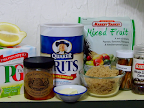Background
South Africa is a very diverse country, and it cuisine reflects this. In addition to the numerous tribes that go back to the origins of humans, one also finds the influence of Dutch colonists, exiled French Huguenots, the British, Indians, and Malaysians. (I was unaware of the Malaysian influence prior to doing this research. They were brought as slave labor by the Dutch in the 17th century and have maintained a distinct tradition.)
Reflecting this diversity we had a large number of distinct options. The option we found first and most often is basically the full English breakfast with a regional sausage called Boerevors. Since we had recently had a full English breakfast we decided to do a little more exploring.
This sent us on a quest to find some good cookbooks. The first book were found was South African Indigenous Foods, which is a collection of recipes collected from across the country to help people make better use of local food resources. It is not very descriptive in terms of background or uses because it is written for natives. It is probably the most rawly authentic cookbook we have found so far in our project.
The books that provided our background were Rainbow Cuisine and A Taste of South Africa. A Taste of South Africa was very authentic calling for ostrich, sorghum, and springbok (a species of gazelle). Rainbow Cuisine provided the most detailed over view of breakfast and the recipes we used.
Given the broad diversity, it was difficult to find a definitively South African breakfast. We decided to sample from both the African and European influences in the cuisine, and chose to make a dried fruit compote and a maize-meal porridge.
Compote of Dried Fruit
- 250 ml fresh squeezed orange juice, about 4 navel oranges
- 125 g of dried fruit
- juice and zest of ¼ lemon
- ¾ tsp brown sugar
- ½ cinnamon stick
- 1 whole clove

- Combine all ingredients in a sauce pan.
- Cover and simmer for 5 minutes.
- Remove from heat and leave it alone for several hours while the fruit absorbs the juice.
- Chill in the refrigerator until ready to serve (keeps up to 5 days).
Maize Porridge
The maize meal used in South Africa is a white meal, and the easiest equivalent found is hominy grits.
- 375 ml water
- 125 ml hominy grits
- ¼ tsp salt
- ½ tbsp butter
- Mix grits, 125 ml water, and salt.
- Boil the rest of the water.
- Gradually stir in the grits-water mixture.
- Reduce the heat and simmer for 15 minutes.
- Mix in the butter.
- Serve with milk and honey.
This breakfast was simple and nice. The fruit compote is nicely sweet and smooth. It provided a nice counter point to the texture of the warm grits. It felt a bit more like a weekday breakfast than a weekend breakfast but it was very nice and it reflected more of an African influence than European.
We will be away next week but we will provide a history of the Schlesinger Library which frequently provides cookbooks for our more obscure countries.

No comments:
Post a Comment